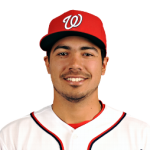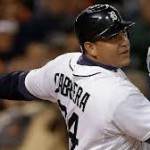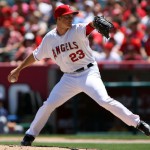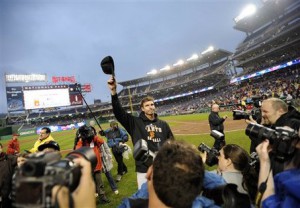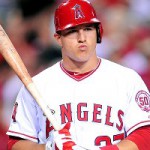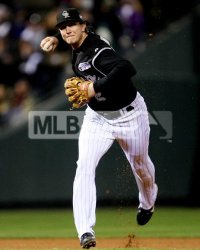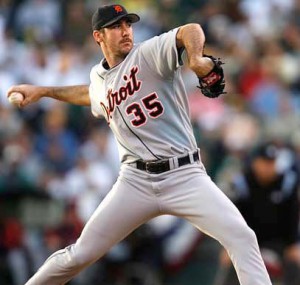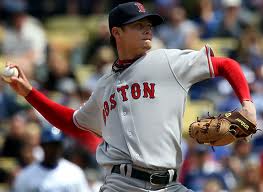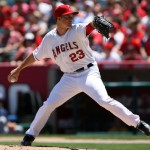
Is Greinke's big new deal going to pay off for the Dodgers? We'll see. Photo Jeff Golden/Getty Images
One of my pet projects of recent years has been to track “major” Starting Pitcher free agent contracts and then to do analysis of how they turned out, on a Dollar per win basis. This post is an analysis of this work along with some interesting conclusions to determine some of the “best” and “worst” free agent contracts ever awarded.
This is mostly an analysis of past performance; there’s plenty of pitchers right now on major contracts that are just too soon into the deal to really draw any conclusions. I’ve included in the spreadsheet all the major contracts signed this past off-season and will continue to do so if these guys get significant deals. But we’ll have to wait a year to see how the first year of the contracts play out. For all contracts that are in the middle of being played out, I’ve calculated how that contract is faring thus far.
Some caveats to the data: For ease of analysis, I depend on the Average Annual Value (AAV) of the contracts as opposed to trying to figure out exactly how many wins were earned in which year of a varying contract amount. Therefore (for example), Gio Gonzalez‘s contract may have only paid him $3.25M in 2012 but I’m using the full AAV of $8.4M for the purposes of the analysis (it would just be far too difficult to calculate each pitcher’s dollar per win on an annualized basis otherwise). Also, I focus on dollars per Win, despite the known limitations of the “Win” statistic. I have gone through and added in Quality Starts to the analysis, but that stat is also flawed in some respects (though it does do a pretty good job of indicating whether or not the starter has done his job). Unfortunately the $/QS doesn’t work out as nicely as $/Win, since Pitcher Wins are still so prevalent in our player analysis. I mean, after all, the goal of the game is to WIN the game, right?
Here’s a quick cut-n-paste from the spreadsheet (which is also available in the Links section to the right and on Google Docs) of some selected fields. See the Google xls for everything. Apologies if this doesn’t present well online. The table is listed in descending order of $/year AAV. Blanks in the Wins and $AAV per win indicate that the contract has yet to begin. I also threw in a couple of non-FA contracts at the end to show what a MLB-minimum successful starting pitcher looks like in comparison.
| Last Name | First Name | Total Value (includes club options) | $/year AAV | Contract Term | Wins | $ AAV per win |
| Clemens | Roger | $28,000,022 | $28,000,022 | 2007 | 6 | $4,666,670 |
| Greinke | Zack | $147,000,000 | $24,500,000 | 2013-2018 | ||
| Sabathia | C.C. | $122,000,000 | $24,400,000 | 2012-16 | 15 | $1,626,667 |
| Lee | Cliff | $120,000,000 | $24,000,000 | 2011-15 | 23 | $2,086,957 |
| Hamels | Cole | $144,000,000 | $24,000,000 | 2013-18 | ||
| Sabathia | C.C. | $69,000,000 | $23,000,000 | 2009-11 | 59 | $1,169,492 |
| Santana | Johan | $137,500,000 | $22,916,667 | 2008-13 | 46 | $2,989,130 |
| Cain | Matt | $127,500,000 | $21,250,000 | 2012-17 | 16 | $1,328,125 |
| Lincecum | Tim | $40,500,000 | $20,250,000 | 2012-13 | 10 | $2,025,000 |
| Halladay | Roy | $60,000,000 | $20,000,000 | 2011-13 | 30 | $1,333,333 |
| Darvish | Yu | $111,700,000 | $18,616,667 | 2012-18 | 16 | $1,163,542 |
| Zambrano | Carlos | $91,500,000 | $18,300,000 | 2008-12 | 50 | $1,830,000 |
| Zito | Barry | $126,000,000 | $18,000,000 | 2007-13 | 58 | $1,862,069 |
| Clemens | Roger | $18,000,000 | $18,000,000 | 2005 | 13 | $1,384,615 |
| Peavy | Jake | $52,000,000 | $17,333,333 | 2010-12 | 25 | $2,080,000 |
| Matsuzaka | Daisuke | $103,000,000 | $17,166,667 | 2007-12 | 50 | $2,060,000 |
| Beckett | Josh | $68,000,000 | $17,000,000 | 2011-14 | 20 | $1,700,000 |
| Weaver | Jered | $85,000,000 | $17,000,000 | 2012-16 | 20 | $850,000 |
| Lackey | John | $82,500,000 | $16,500,000 | 2010-14 | 26 | $1,903,846 |
| Burnett | A.J. | $82,500,000 | $16,500,000 | 2009-13 | 50 | $1,320,000 |
| Verlander | Justin | $80,000,000 | $16,000,000 | 2010-14 | 59 | $813,559 |
| Sanchez | Anibal | $80,000,000 | $16,000,000 | 2013-17 | ||
| Schmidt | Jason | $47,000,000 | $15,666,667 | 2007-09 | 3 | $15,666,667 |
| Hernandez | Felix | $78,000,000 | $15,600,000 | 2010-14 | 40 | $1,170,000 |
| Wilson | C.J. | $77,500,000 | $15,500,000 | 2012-16 | 13 | $1,192,308 |
| Hampton | Mike | $121,000,000 | $15,125,000 | 2001-08 | 56 | $2,160,714 |
| Brown | Kevin | $105,000,000 | $15,000,000 | 1999-05 | 72 | $1,458,333 |
| Lowe | Derek | $60,000,000 | $15,000,000 | 2009-12 | 49 | $1,224,490 |
| Hamels | Cole | $15,000,000 | $15,000,000 | 2012 | 17 | $882,353 |
| Kuroda | Hiroki | $15,000,000 | $15,000,000 | 2013 | ||
| Mussina | Mike | $88,500,000 | $14,750,000 | 2001-06 | 92 | $961,957 |
| Oswalt | Roy | $73,000,000 | $14,600,000 | 2007-11 | 61 | $1,196,721 |
| Buehrle | Mark | $58,000,000 | $14,500,000 | 2012-15 | 13 | $1,115,385 |
| Peavy | Jake | $29,000,000 | $14,500,000 | 2013-14 | ||
| Buehrle | Mark | $56,000,000 | $14,000,000 | 2008-11 | 54 | $1,037,037 |
| Martinez | Pedro | $54,000,000 | $13,500,000 | 2005-08 | 32 | $1,687,500 |
| Halladay | Roy | $40,000,000 | $13,333,333 | 2008-10 | 58 | $689,655 |
| Martinez | Pedro | $92,000,000 | $13,142,857 | 1998-04 | 117 | $786,325 |
| Danks | Jon | 65,000,000 | $13,000,000 | 2012-15 | 3 | $4,333,333 |
| Park | Chan Ho | $65,000,000 | $13,000,000 | 2002-06 | 33 | $1,969,697 |
| Dempster | Ryan | $52,000,000 | $13,000,000 | 2009-12 | 48 | $1,083,333 |
| Haren | Dan | $13,000,000 | $13,000,000 | 2013 | ||
| Jackson | Edwin | $52,000,000 | $13,000,000 | 2013-16 | ||
| Colon | Bartolo | $51,000,000 | $12,750,000 | 2004-07 | 46 | $1,108,696 |
| Carpenter | Chris | $50,800,000 | $12,700,000 | 2008-11 | 44 | $1,154,545 |
| Arroyo | Bronson | $25,000,000 | $12,500,000 | 2009-10 | 32 | $781,250 |
| Dickey | R.A. | $25,000,000 | $12,500,000 | 2013-14 | ||
| Perez | Oliver | 36,000,000 | $12,000,000 | 2009-11 | 3 | $12,000,000 |
| Silva | Carlos | $48,000,000 | $12,000,000 | 2008-12 | 15 | $4,000,000 |
| Millwood | Kevin | $60,000,000 | $12,000,000 | 2006-10 | 52 | $1,153,846 |
| Kuroda | Hiroki | $12,000,000 | $12,000,000 | 2011 | 13 | $923,077 |
| Pettitte | Andy | $12,000,000 | $12,000,000 | 2013 | ||
| Haren | Dan | $47,750,000 | $11,937,500 | 2009-12 | 54 | $884,259 |
| Kuroda | Hiroki | $35,300,000 | $11,766,667 | 2008-10 | 28 | $1,260,714 |
| Arroyo | Bronson | $35,000,000 | $11,666,667 | 2011-13 | 21 | $1,666,667 |
| Lincecum | Tim | $23,000,000 | $11,500,000 | 2010-11 | 29 | $793,103 |
| Mussina | Mike | $22,141,452 | $11,070,726 | 2007-08 | 31 | $714,240 |
| Dreifort | Darren | $55,000,000 | $11,000,000 | 2001-05 | 9 | $6,111,111 |
| Meche | Gil | $55,000,000 | $11,000,000 | 2007-11 | 29 | $1,896,552 |
| Lilly | Ted | $33,000,000 | $11,000,000 | 2011-13 | 17 | $1,294,118 |
| Jackson | Edwin | $11,000,000 | $11,000,000 | 2012 | 10 | $1,100,000 |
| Harrison | Matt | $55,000,000 | $11,000,000 | 2013-17 | ||
| Carpenter | Chris | $21,000,000 | $10,500,000 | 2012-13 | 0 | (0 wins) |
| Ryu | Hyun-Jin | $61,700,000 | $10,283,333 | 2013-18 | ||
| Neagle | Denny | $51,000,000 | $10,200,000 | 2001-05 | 19 | $2,684,211 |
| Lilly | Ted | $40,000,000 | $10,000,000 | 2007-10 | 54 | $740,741 |
| Darvish | Yu | $60,000,000 | $10,000,000 | 2012-18 | 16 | $625,000 |
| Kuroda | Hiroki | $10,000,000 | $10,000,000 | 2012 | 16 | $625,000 |
| Pavano | Carl | $39,950,000 | $9,987,500 | 2005-08 | 9 | $4,438,889 |
| Wolf | Randy | $29,750,000 | $9,916,667 | 2010-12 | 31 | $959,677 |
| Johnson | Josh | $39,000,000 | $9,750,000 | 2010-13 | 22 | $1,329,545 |
| Greinke | Zack | $38,000,000 | $9,500,000 | 2009-12 | 67 | $567,164 |
| Washburn | Jarrod | $37,000,000 | $9,250,000 | 2006-09 | 32 | $1,156,250 |
| Igawa | Kei | $46,000,000 | $9,200,000 | 2007-11 | 2 | $23,000,000 |
| Cain | Matt | $27,250,000 | $9,083,333 | 2010-12 | 41 | $664,634 |
| Lowe | Derek | $36,000,000 | $9,000,000 | 2005-08 | 54 | $666,667 |
| Matsuzaka | Daisuke | $52,000,000 | $8,666,667 | 2007-12 | 50 | $1,040,000 |
| Beckett | Josh | $42,000,000 | $8,400,000 | 2007-10 | 55 | $610,909 |
| Gonzalez | Gio | $42,000,000 | $8,400,000 | 2012-16 | 21 | $400,000 |
| Guthrie | Jeremy | $25,000,000 | $8,333,333 | 2013-16 | ||
| Ortiz | Russ | $33,000,000 | $8,250,000 | 2005-08 | 7 | $4,714,286 |
| Schmidt | Jason | $40,000,000 | $8,000,000 | 2002-06 | 71 | $563,380 |
| Buchholz | Clay | $30,000,000 | $7,500,000 | 2012-15 | 11 | $681,818 |
| Lester | Jon | $43,000,000 | $7,166,667 | 2009-14 | 58 | $494,253 |
| Hamels | Cole | $20,500,000 | $6,833,333 | 2009-11 | 36 | $569,444 |
| Wainwright | Adam | $36,000,000 | $6,000,000 | 2008-13 | 64 | $468,750 |
| Ryu | Hyun-Jin | $36,000,000 | $6,000,000 | 2013-18 | ||
| Webb | Brandon | $28,000,000 | $5,600,000 | 2006-10 | 56 | $500,000 |
| Lee | Cliff | $23,000,000 | $4,600,000 | 2006-10 | 67 | $343,284 |
| Igawa | Kei | $20,000,000 | $4,000,000 | 2007-11 | 2 | $10,000,000 |
| Jimenez | Ubaldo | $23,750,000 | $3,958,333 | 2009-14 | 53 | $298,742 |
| Jimenez | Ubaldo | $10,000,000 | $2,500,000 | 2009-12 | 53 | $188,679 |
| Price | David | $9,750,000 | $1,950,000 | 2007-11 | 41 | $237,805 |
| Buchholz | Clay | $555,000 | $555,000 | 2011 | 6 | $92,500 |
| Buchholz | Clay | $443,000 | $443,000 | 2010 | 17 | $26,059 |
Here’s some interesting facts, that come out of this analysis (some of these points can also be seen at the amazing Cots Salary database, now at Baseball Prospectus, and are confirmed in my spreadsheet tracking the same):
- Largest total Starting Pitcher Contract ever signed: Felix Hernandez‘s brand new 7 year, $175M extension, beating out the previous record-holder CC Sabathia (7yrs/$161M in 2009). Zack Greinke‘s just signed 6yr/$147M would be the 2nd biggest ever signed, and Cole Hamel‘s 6yr/$144M contract the third. Will our own Stephen Strasburg come close to broaching these limits when he hits the FA market? We’ll see.
- Largest Single-Season AAV: Roger Clemen‘s 1yr/$28M deal in 2007. The next closest are Hernandez’s $25M/year, Greinke $24.5M/year and Sabathia’s $24.4M figures.
(A couple of quick caveats to the above lists: CC Sabathia subseqently opted out of his 7/161 deal, so it basically got turned into a 3yr/$69M deal. And, techncially Hernandez’s deal ripped up the last two years of his previous deal to replace it with the 7/175 deal; lots of people are looking at the new deal as a 5 year extension with an even higher AAV. I don’t see it the same way; I see it as a replacement of the existing contract years).
What are some of the worst deals ever made?
- Worst Ever Starting Pitcher Contract: Kei Igawa‘s 2007 deal with the Yankees, which was 5yrs/$20M but included a $26M posting fee, is the worst $AAV per Win contract ever signed. Igawa went 2-4 in 13 starts over the life of this 5 year deal, equating to $23M per win for his team. He spent the last two seasons of this contract buried in AAA.
- Worst non-Posting fee Starting Pitcher Contract: Jason Schmidt‘s 3yr/$47M contract with the Dodgers. Schmidt made 10 total starts and went 3-6, equating to $15.6M per win.
Other names on the “Worst Starting Pitcher Contract” category include Oliver Perez ($12M/win), Darren Dreifort (6.1M/win), Russ Ortiz (4.7M/win), Carl Pavano ($4.4M/win) and Carlos Silva ($4M/win). Most of these contracts are well known to baseball fans and are commonly thrown around when talking about the worst historical FA contracts.
How about some of the “Best” Contracts ever signed? Lots of players have signed small one year deals and won double-digit games, so those really cannot count. Starting with an arbitrary floor of a $50M free agent contract, here’s the best value FA contracts ever signed:
- Pedro Martinez: 7yr/$92M, during which he went 117-37 for the Red Sox for a $786k/win total.
- Justin Verlander: He’s in the middle of a 5yr/$80M contract and for the first 3 years he’s 59-22 for $813k/win.
- Mike Mussina went 92-53 in his 6yr/$88.5M contract for $961k/win.
Jered Weaver and Yu Darvish deserve some mention here; they’re both in the first year of $50M+ contracts and are easily earning their pay in terms of $/win.
So what does this data mean? Here’s some conclusions.
- It used to indicate that if you got about one (1) pitcher Win per million dollars spent on a player in the Free Agent market that you were doing great. Look at our own Edwin Jackson in 2012: we signed him for $11M, he went 10-11 for us, equating to $1.1M/win. Good value frankly.
- If you’re getting anything between $1.25M and $1.5M/win, there may be some complaints about the value of the contract. Not always, but most of the time it indicates that either the pitcher is underperforming or is overpaid.
- Anything over $2M/win is usually considered a bust. Nearly every contract in the $2M/win in AAV and above has been mentioned and criticized as being a bad contract; the list of “worst ever” above starts at $4M/win and goes higher.
- If you pay a starter anything more than about $18M/season, you’re really going to have a hard time getting value back. There’s only been a handful of 20-game winners over the past 5 years or so, but paying a starter $24M like Greinke is getting is almost certainly going to be regretted at some point. An injury or a lost season completely blows the $AAV/win.
- It illustrates more clearly than anywhere else the value of a top-notch, pre-Arbitration starter. Take Clay Buchholz for example; in 2010 he was 17-7 while earning the league minimum of $443k. That equates to $26,059/win on the same staff that was busy paying Daisuke Matsuzaka $2.06M per win (when adding in the $52M posting fee). Buchholz has struggled since then, but teams that depend on these pre-arb starters (Tampa, Oakland, Washington to a certain extent) save untold amounts of FA dollars as a result.
- Lastly, and this is the hard part, this analysis is getting nearly impossible to do across baseball eras because of the general inflation of contracts and especially because of the bonanza of FA dollars being thrown out there right now. Pedro Martinez at the top of his game signed a 7yr/$92M deal. Imagine what he’d get today? It could be twice that. He was coming off a 1997 season in which he struck out 305 batters, had a 1.90 ERA, a 219 ERA+ and won the Cy Young award. So perhaps going forward a general $1.25M/win is a more accurate barometer for whether or not a pitcher has “earned” his contract. But there’s no easy way to draw a line in the free agency sand and say that before yearX $1M/win was a good barometer while after yearY $1.25M/win is a good barometer.
- A caveat to the $1M/win benchmark; there are different standards for obtaining wins. If you sign a $3M 1 year deal and then subsequently go 3-12 with a 6.00 ERA … while it looks like you reached the $1m/win threshold in reality you were, well, awful. This analysis only really holds up for major FA contracts paying in excess of $10M/year.
Lastly, for comparison purposes, here’s the above analysis looks for the 2012 Nationals pitching staff. Keep in mind that the $/win figures for pre-arbitration pitchers vastly skew the analysis.
| Last Name | First Name | Total Value (includes club options) | $/year AAV | Starts | QS | Wins | $ per QS | $ AAV per win |
| Strasburg | Steven | $15,100,000 | $3,775,000 | 45 | 28 | 21 | $539,286 | $719,048 |
| Gonzalez | Gio | $42,000,000 | $8,400,000 | 32 | 22 | 21 | $381,818 | $400,000 |
| Zimmermann | Jordan | $2,300,000 | $2,300,000 | 32 | 24 | 12 | $95,833 | $191,667 |
| Jackson | Edwin | $11,000,000 | $11,000,000 | 31 | 17 | 10 | $647,059 | $1,100,000 |
| Wang | Chien-Ming | $4,000,000 | $4,000,000 | 5 | 0 | 2 | #DIV/0! | $2,000,000 |
| Detwiler | Ross | $485,000 | $485,000 | 27 | 12 | 10 | $40,417 | $48,500 |
| Lannan | John | $5,000,000 | $5,000,000 | 6 | 2 | 4 | $2,500,000 | $1,250,000 |
| Maya | Yunesky | $8,000,000 | $2,000,000 | 10 | 1 | 1 | $6,000,000 | $6,000,000 |
The counting figures for Starts/QS/Wins/Losses are cumulative for the life of whatever contract the player is on. So for Strasburg, he was basically in the 4th year of his original 4 year deal, hence the 45 total starts in those 4 years. For guys like Zimmermann and Detwiler, the analysis is just for 2012 since they were playing on one-year deals.
The 2012 Nats have $AAV per win values all over the road:
- Detwiler‘s $48k per win in 2012 is an amazing bargain; he got 10 wins while pitching for basically the MLB minimum. And, Zimmermann‘s 12-win season while on a first-year Arbitration salary also represented about 20% of what those wins would have cost on the FA market.
- Jackson produced almost exactly at the expectations for a FA starter; $11M contract, 10 wins, and $1.1M per win. In 2013 if we get 12-13 wins from Dan Haren, we’ll be doing alright.
- Lannan provided just on the borderline of bust production, as you’d expect for someone who got paid $5M to give the team 6 starts.
- Wang: $4M salary, 5 starts, zero quality starts, 2 wins and a $2M/win price tag. Yes; he was a bust.
- Lastly Mr. Yunesky Maya. The team has now paid him $6M over three years. In that time he’s gotten 10 MLB starts and has produced exactly one Quality start and one win. That’s $6M the team has paid for each win, in the range for one of the worst dollar-per-win contracts ever signed. Of course, the Nats only signed him for $8M (not the $46M contract Igawa got), so the downside is limited. But it does illustrated just how badly this deal has gone for the team.
